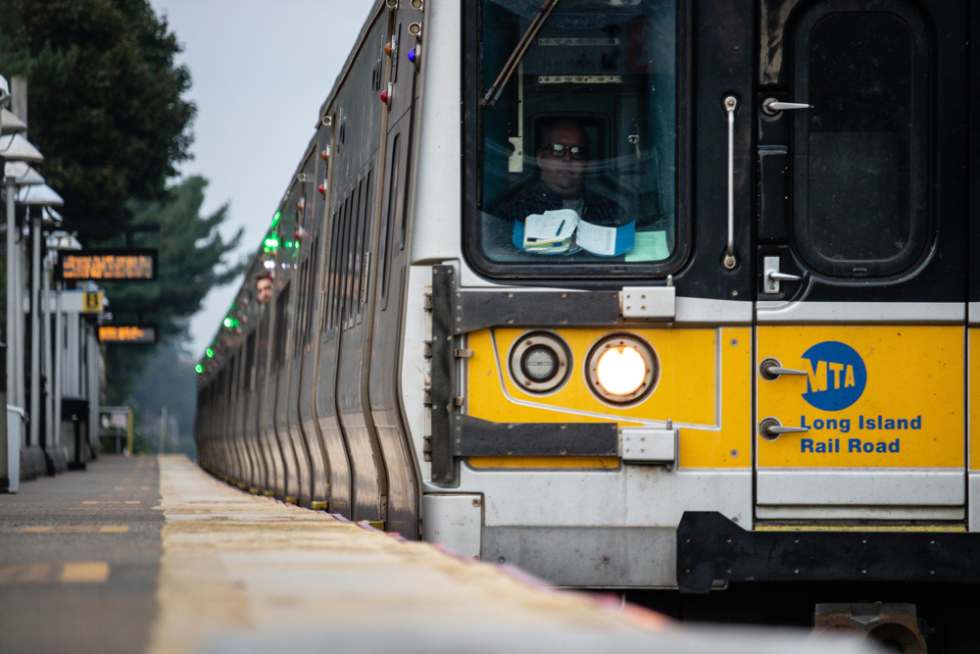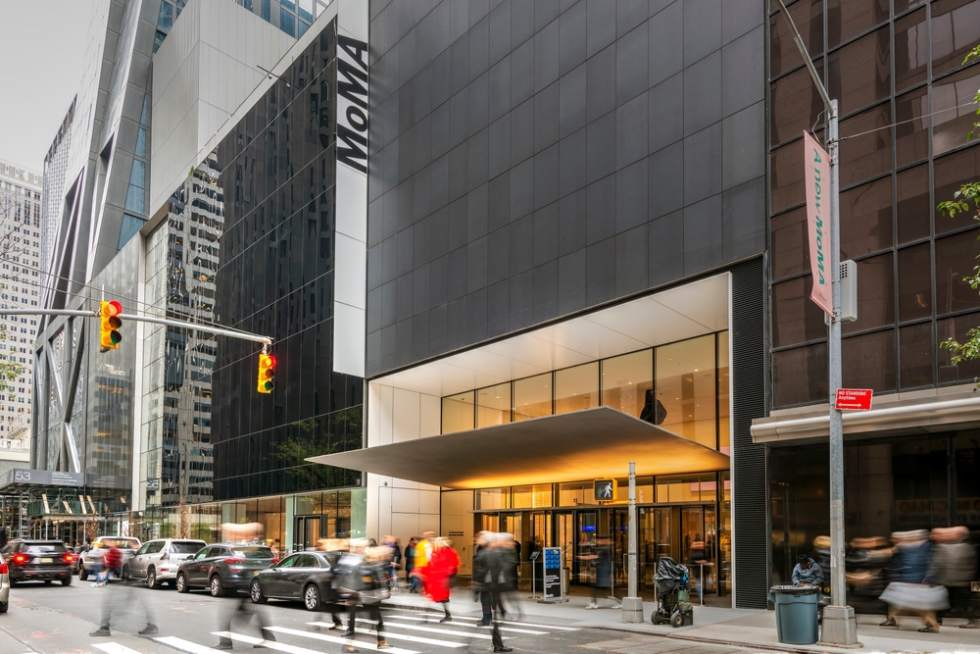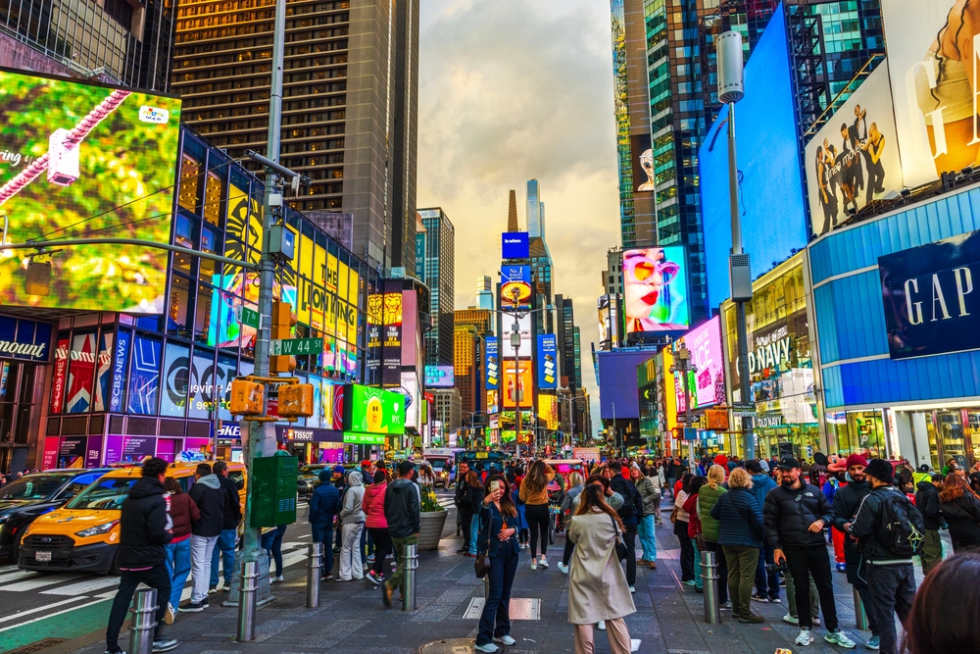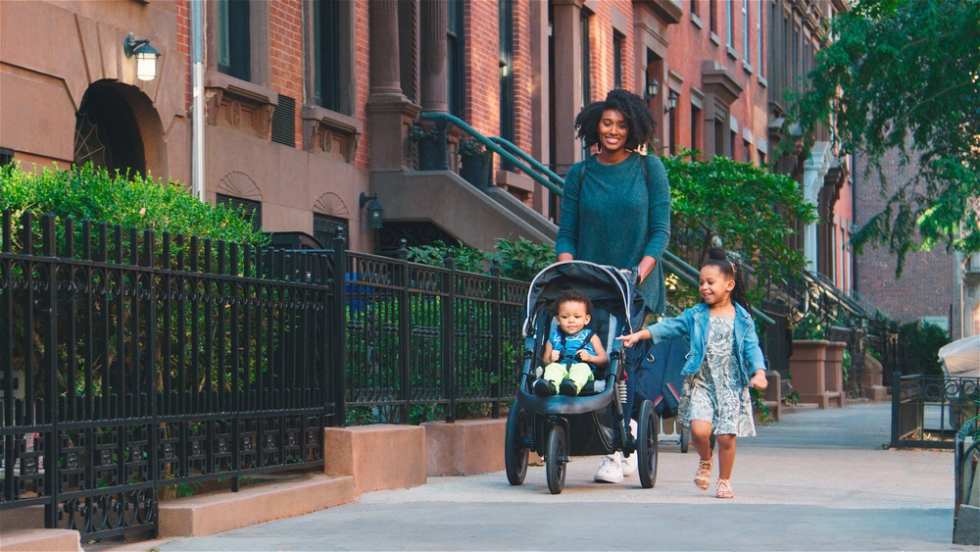South Bank at Quarry Trails
- 93 units available
- Studio • 1 bed • 2 bed • 3 bed
- Amenities
In unit laundry, Patio / balcony, Granite counters, Pet friendly, Stainless steel, Walk in closets + more

Are the bright lights and endless energy of New York City calling your name? You’re not alone. Known as the “city that never sleeps,” New York attracts newcomers with its global job market, world-class culture, and neighborhoods that each feel like their own small city. From Wall Street careers to Broadway shows, NYC continues to draw people chasing opportunity and excitement.
But life in New York isn’t without challenges. The city is one of the most expensive in the U.S., traffic and commutes can be grueling, and housing competition is fierce. Below, we’ll break down the key pros and cons of living in New York. We’ll also give you insights on the cost of living, jobs, schools, safety, and neighborhoods.
Methodology: We used internal Apartment List data and cross-referenced with housing and neighborhood data from Rent.com and Apartments.com to provide the most accurate snapshot of New York City living as of September 2025. Crime data is sourced from CrimeGrade.org and Weichert.
| Data Point | |
|---|---|
| Population | 8,804,190 |
| Average One-Bedroom Rent Price | $5,249 |
| Average Two-Bedroom Rent Price | $7,879 |
| Year-Over-Year Rent Change | +2% |
| Median Household Income | $76,577 |
| Popular Neighborhoods in New York City | Some of the most popular New York City neighborhoods include the Upper East Side, Upper West Side, Harlem, Tribeca, and Greenwich Village. |
New York City is unrivaled as a global career center, whether it’s finance, media, tech, fashion, or nonprofit work. To put it succinctly, opportunities are abundant. Job seekers benefit from frequent networking events, industry meetups, and job fairs across the city powered by Workforce1 centers, which offer training, resume help, and job placement.
NYC’s density also provides spontaneous networking. Cafés often double as professional hubs, and there’s no shortage of ways to meet people.

Rent rates in New York are among the highest in the nation. The average one-bedroom rent is around $5,249/month, while the average asking rent across two-bedroom units is $7,879. Overall, the cost of living is around 72.5% higher than the national average.
The city's rental crisis persists, even after the 2023 Airbnb crackdown failed to increase housing supply or bring down prices. All this means affordability continues to be a major concern for locals.
Beyond skyscrapers and subways, NYC offers expansive natural escapes within an easy drive or train ride. Popular destinations like the Hudson Valley, the Catskills, the beaches of Long Island, and upstate parks are perfect for hiking, swimming, and leaf-peeping. Weekend getaways from the city are both diverse and accessible.
NYC’s rental landscape is notoriously competitive. Nearly 29% of leases involve bidding wars, and vacancy rates remain ultra-low, especially in Manhattan. Prices continue climbing even as listings remain tight. Manhattan’s average rent recently hit $5,429 per month for one-bedroom units, reflecting surges driven by demand and rising construction costs. New affordable rent-stabilized units are hard to find, with many hidden from public listings.
No city in the world can match New York's sheer cultural depth. With over 800 languages spoken and immigrant communities from Latin America, Asia, Africa, and Europe, the diversity is extraordinary. Neighborhoods like Queens and Brooklyn are living showcases of global traditions. This multicultural mix is woven into the city’s food, festivals, and daily life.

While less car-dependent than many metros, NYC still suffers from air pollution, particularly near highways, tunnels, and industrial zones. Dense congestion combined with older building stock contributes to smog, especially on hot days. This can be a concern for individuals with respiratory issues or families with young children.
From Michelin-rated fine dining to street-side dumpling spots, NYC is unmatched in culinary variety. Every neighborhood offers hidden gems, with flavors ranging from authentic Haitian street food to experimental fusion fare. Whether you're exploring a dim-sum spot in Flushing or a tapas bar in the East Village, every meal is an adventure.
While NYC offers high income potential, taxes can quickly offset it. Income tax rates in New York are incredibly high at 10.9%. Plus, you have to reckon with property, sales, and transit taxes. This can significantly impact take-home pay, especially for middle-income earners.
The MTA subway system is the largest in North America and runs 24/7 across the city. Add a dense bus network, extensive bike lanes, and commuter rails into New Jersey, Long Island, and beyond, and working without a car becomes entirely feasible in NYC. Recent infrastructure upgrades like the Second Avenue Subway and East Side Access improve service even further

High population density means perpetual hustle. Sidewalks are crowded, and rush-hour seating on subways is rare. Streets are often clogged with traffic, and the recent congestion pricing program adds costs for driving in central Manhattan. For anyone not used to crowds, it can be overwhelming.
Unlike cities with weather monotony, NYC experiences a full range: vibrant springs, hot summers, crisp autumn foliage, and cold, snowy winters. This seasonal variety is perfect for those who enjoy dressing for the weather or seasonal activities. However, with that said…
NYC summers are muggy and hot, with temperatures pushing into the 90s°F combined with humidity. Winters can be frigid, with snowstorms and icy sidewalks that hamper commutes. Those sensitive to extreme weather should be prepared with an adequate wardrobe and contingency plans.
New York is a cultural epicenter. From Broadway to street art, poetry slams to jazz in Harlem, museums like MoMA and the Met, and independent theater across the boroughs, there’s creative expression around every corner. Cultural engagement has no limits here, whether you're attending a gallery opening or catching a subway string quartet.

While many parts of NYC are safe and well-policed, and the city has a relatively high B- Crime Grade, crime rates vary significantly by neighborhood. Residents should look at area-specific data to determine how safe different neighborhoods might be. Some zones face elevated property crime or pedestrian safety risks, even though overall violent crime continues a long-term decline.
New York's public park system is unrivaled in reach: 28,000 acres of green space, from the iconic Central Park to beaches, wetlands, and playgrounds across all five boroughs. Nearly every resident lives within a short walk of a park, whether it's a vast lawn or a local play spot.
Yes, New York City is a good place to live for renters who want career opportunities, cultural access, and a fast-paced lifestyle. One-bedroom apartments average around $5,429, while two-bedrooms cost about $7,879, making it more expensive than most U.S. cities.
Renters can choose from luxury towers in Manhattan, brownstones in Brooklyn, or more affordable apartments in Queens and the Bronx. While high housing costs and taxes are challenges, NYC’s public transit, world-class dining, and global job market continue to attract people seeking opportunity and variety in one of the world’s most connected cities.
| Apartment Size | Average Square Footage | Average Rent in New York City | U.S. Average Rent |
|---|---|---|---|
| One-Bedroom | ~750 sq. ft. | $5,249 | $1,755 |
| Two-Bedroom | ~1,100 sq. ft. | $7,879 | $2,194 |
Living in New York City means being in one of the busiest and most influential cities in the world. Residents enjoy access to endless job opportunities, world-class dining, Broadway shows, and cultural institutions like the Metropolitan Museum of Art and the American Museum of Natural History. Weekends can mean strolling through Central Park, catching a Yankees or Knicks game, or exploring food festivals across the boroughs.
Neighborhoods offer distinct lifestyles:
While the cost of living is high and commuting can be stressful, many renters see New York as unmatched for opportunity, culture, and variety.

New York’s culture is built on diversity, creativity, and nonstop energy. Broadway and Off-Broadway theaters deliver world-class performances, while venues like Madison Square Garden and Carnegie Hall host everything from concerts to sports. Each borough has its own identity: Harlem is known for its jazz and soul food, Queens for its global cuisines, and Brooklyn for its indie music and art scene.
Food is central to city life, from Michelin-starred fine dining to dollar-slice pizza and food trucks on nearly every corner. Sports are another defining feature, with loyal fans packing stadiums for the Yankees, Mets, Knicks, Nets, Rangers, and Giants. Festivals like the Puerto Rican Day Parade, Lunar New Year, and Pride March highlight the city’s cultural range. While it’s crowded and expensive, many residents find New York unmatched for cultural opportunities and community expression.
New York City is one of the most expensive places to live in the United States. The overall cost of living is more than 72% higher than the national average, and housing is the biggest factor. Groceries, transportation, and utilities are also above average, though healthcare costs are closer to national levels. While salaries in NYC are often higher than elsewhere, renters should budget carefully before making the move.
Here’s how the cost-of-living categories break down for New York City compared to New York State and the U.S. overall:
| Cost of Living | New York City | New York | U.S. Average |
|---|---|---|---|
| Overall | 172.5 | 121.5 | 100.0 |
| Grocery | 116.6 | 103.8 | 100.0 |
| Health | 127.6 | 120.7 | 100.0 |
| Housing | 224.3 | 127.9 | 00.0 |
| Utilities | 150.5 | 115.9 | 100.0 |
| Transportation | 181.1 | 140.7 | 100.0 |
| Miscellaneous | 136.4 | 121.8 | 100.0 |
New York City has one of the largest and most diverse job markets in the country, with strengths in finance, healthcare, tech, media, and education. Major employers include JPMorgan Chase, Mount Sinai Health System, NewYork-Presbyterian Hospital, and tech companies expanding their presence in Manhattan and Brooklyn.
While opportunities are vast, competition for top roles can be intense, and many industries require advanced degrees or specialized experience. The unemployment rate in NYC typically trends close to or just above the national average, but steady growth in healthcare and technology continues to create opportunities for renters planning to stay long-term.
New York City’s crime rates have declined dramatically since the 1990s, making it one of the safest large cities in the U.S. Overall, NYC has lower violent crime rates than many major metros, though property crimes like theft and burglary remain more common.
Neighborhood differences are significant. According to CrimeGrade.org, New York receives a B- grade for overall crime, which is why it’s so important to look at neighborhood-level data before choosing an apartment.
Areas like Midtown Manhattan (C-) and parts of the Bronx (C-) see more incidents, while neighborhoods such as the Upper East Side (A-) or Long Island (B+) report lower crime levels.
Schools in New York City fall under the NYC Department of Education, the largest public school district in the U.S. Performance varies widely across the city, with some schools ranking among the best in the country while others face challenges with overcrowding and resources. Families often look to selective public schools, specialized programs, and charter schools for higher academic performance.
For higher education, New York is home to world-class institutions such as Columbia University and New York University, along with a robust public system through the City University of New York (CUNY), making it a global hub for students across disciplines.
| School/University | Type | Niche Rating |
|---|---|---|
| Stuyvesant High School | High School | A+ |
| Bronx High School of Science | High School | A+ |
| Staten Island Technical High School | High School | A+ |
| New Explorations into STEM | Middle School | A+ |
| Success Academy Charter School | Elementary | A+ |
New York City can be a good place for families, especially in neighborhoods with strong schools, parks, and community amenities. Areas like Park Slope (Brooklyn), Forest Hills (Queens), and parts of Staten Island are popular for quieter streets, family-friendly housing, and access to green space. Families also benefit from cultural resources such as the American Museum of Natural History, Central Park Zoo, and countless libraries.
However, challenges include high housing costs, limited space, and varying public school quality depending on the district. Families often prioritize selective public schools or private/charter options to ensure consistent education quality.

New York neighborhoods range from bustling hubs in Manhattan to quieter suburban-style communities in Brooklyn, Queens, and Staten Island. Renters can choose high-rise apartments in Midtown or more affordable options in the outer boroughs, depending on lifestyle and budget.
Here’s a look at average rent prices in some of NYC’s most popular spots (as of 2025):
| Neighborhood | Average One-Bedroom Rent | Average Two-Bedroom Rent |
|---|---|---|
| Upper East Side | $5,628 | $7,906 |
| Harlem | $4,950 | $8,984 |
| Park Slope (Brooklyn) | $4,400 | $4,930 |
| Flatbush | $2,612 | $3,750 |
Living in New York City can be rewarding if you want nonstop energy, career opportunities, and world-class dining, culture, and entertainment at your doorstep. Renters can choose from luxury high-rises in Manhattan, historic brownstones in Brooklyn, or more affordable apartments in Queens and the Bronx.
That said, NYC comes with trade-offs: high rents, dense crowds, and an often-intense pace of life. If you’re still weighing your options, check out more Renter Life guides to compare cities. Ready to see if New York is the right fit for you? Take our Apartment List quiz to find your best rental match today.
The biggest downsides include very high housing costs, heavy traffic, and crowded public spaces. New York also has higher-than-average state and city taxes compared to most U.S. metros. Noise, long commutes, and the fast pace of life can be challenging for some renters.
People move to New York City for its unmatched career opportunities, global cultural influence, and diverse neighborhoods. It’s a major center for finance, media, healthcare, and tech, drawing professionals from around the world. Many also move for education, with universities like NYU and Columbia, or for the arts, food, and lifestyle only New York can offer.
High living expenses, including rent and childcare, are the primary risks for residents. Certain neighborhoods also report higher crime rates, though this varies significantly across boroughs. Pollution and congestion are ongoing concerns, and renters may find competition for apartments stressful in such a competitive housing market.
According to the MIT Living Wage Calculator, a single adult in New York City typically needs at least $68,000 annually to live comfortably. For a family of four, the requirement is closer to $153,000, depending on the borough and lifestyle. These estimates account for rent, food, transportation, healthcare, and taxes.

In unit laundry, Patio / balcony, Granite counters, Pet friendly, Stainless steel, Walk in closets + more
In unit laundry, Granite counters, Hardwood floors, Dishwasher, Pet friendly, 24hr maintenance + more